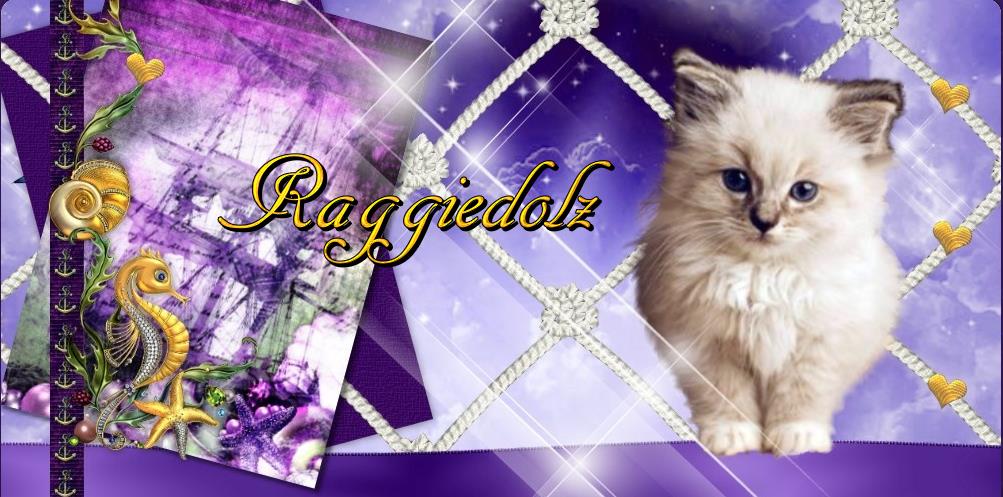The Ragdoll cat has the silkiest rabbit-like fur that requires only twice weekly grooming and has low shedding qualities. They have vivid blue eyes and are generally a relaxed happy cat with a laid back attitude. They are known for their exceptionally tolerant dispositions and sweet docile temperaments. They tend to go limp when picked up, hence the name ‘ragdoll’. They make excellent pets in households with children and other pets as well as being the ideal companion for the elderly. They are lap cats who love to be loved. If you want a bed companion then this is the breed for you the Rags follow you around like a small dog and if you have to leave them alone for a few hours they wait patiently for you to return home. However just as humans have individual differences the Rags also have special unique personalities. In my own cattery I have an aloof one, one who demands constant attention, one who knows she is a Princess and wants to be treated accordingly and yet another who you can guarantee is always in trouble. All of them are distinct personalities, fun to watch, fun to be with.
The show Rags love to be groomed and prepared for the shows and they love going to the hotels after a hard day preening and being on their best behaviour they let their hair down by chasing each other around until they all curl up on the bed exhausted.
Discuss your unique needs with the breeder you choose and talk about your own circumstances that may need consideration. Do you have other animals, children are you able to keep the Ragdoll safe indoors? These lovely cats are not equipped to survive in the wild and cannot catch food or even defend themselves outside and this must be taken into account if you adopt one (or more). A good breeder will not give you bad advice as their reputation is valuable to them. Breeders love to talk about their babies and I am no exception.
Reputable breeders of this exquisite breed show their cats at cat shows to strive to produce the nearest to perfect Ragdoll they can. By showing their Rags the breeders reputation grows and selling their kittens in this way maintains an ethical breed standard. There is usually a waiting list for kittens from reputable breeders.
Ragdolls are a medium length cat but they are prone to obesity. They can grow to be quite large and can range from 15-20 pounds. They only show full colour and size around 3 years of age.
Ragdolls are born all white and later develop into some of these colours : seal, chocolate, blue, lilac, red, cream and tortie. They have 3 colours patterns . The bluer the eyes the better however with some of the dilute colours (blues and creams) there can be a slight loss of colour. However the ragdoll is a blue-eyed pointed cat pointed means colour on the tail, ears, and some type of face mask.
SEAL= whose colour ranges from ivory to pale beige.
BLUE= cold with bluish white to pale grey, no sign of any brown and the paws are dark blue.
CHOCOLATE= with an ivory body warm milk to dark chocolate.
LILAC= magnolia white with pink to lavender paws, dove-grey to warm lavender.
You may also learn of the Bi-colour which has an inverted V shaped marking between the eyes expanding to the muzzle. They are dark at the points with a saddle strip on the back and white – fur on the body. The nose pad and paws are pink classic colour-point ragdolls have markings like the Siamese, mitted have white feet in the front (Mittens) and white hocks on the back (boots). All Rags have a beautiful bushy tail.
Raggiedolz also come in solid colour, mink, sepia, silver and smoke. These lines have always been in the ragdoll since Anne Baker the first breeder of the ragdoll and creator started breeding them in the 1960″s.
Lets now talk about HCM which buyers ask about all the time and I am glad they have done their research.
HCM Hypertrophic cardiomyopathy is a recognised genetic condition in cats and long tern research in Main Coon cats identifies a gene mutation DNA alteration cardiac myosin-binding protein C3 which was strongly associated with HCM. This was seen in the long term research colony of Main Coon cats. Please ensure that all kittens parents have been HCM tested as clear.
If you require further information of the breed standards for showing then a good resource is The International Cat Association (TICA) and the Cat Fanciers Association (CFA).
